Doi
Ang Kang
(Updated 06/05/19) |
Introduction |
|
|
|
Doi Ang Kang, in Chiang Mai province,
is an area on the border with Myanmar (Burma) consisting of
a number of peaks and steep ridges that, although largely
deforested farmland, contain a lot of scrubby vegetation and
forest patches which provide enough habitat to house a good
number of interesting bird species, many of which are found
in few other parts of the country.
One of the delights of Doi Ang Kang is that the scenery is
some of the most spectacular in the country and there is often
cooler weather than in the lowlands, together with some tasty
fresh food. This region is a very relaxing place to visit
with plenty of opportunities for walking and birding in the
surrounding countryside, although one must be prepared for
some steep hikes. A number of small hill tribe villages
are dotted around the region as are a few Thai military outposts
which occasionally get involved in cross-border disagreements
with nearby Burmese military installations, which resemble
fortifications from a bygone age.
Birding in this region can is usually rewarding and at the
right time of year (December to March) there can be many migrant
species that are found at few other places in Thailand and
there are some local specialities which are present all year
round with some of those being easier to find in the wet season. |
|
Birding Highlights |
|
A number of bird species that are seen at few other sites
are specialities of Doi Ang Kang. Crested Finchbill is seen
by most visitors, but at certain times of the year it can
be surprisingly difficult to find due to its nomadic nature.
Red-faced Liocichla is another treat but again it can be quite
tricky to see as it skulks in scrubby undergrowth, but once
it shows its striking red face this species can be spotted
at quite a distance. Another bird lurking in the undergrowth
is Spot-throated Babbler which is seen by only a few, but
listen out for its surprisingly rich song and it can be tracked
down. White-browed Laughingthrush and Rusty-cheeked Scimitar
Babbler are fairly reliable resident species which can be
found in any scrubby growth.
Lots of other northern specialities occur here and in some
"winters" plenty of Thrushes (Black-breasted, Eyebrowed,
Grey-sided, White's and Scaly are normally reported) and other
winter migrants are seen, however, in many years there are
very few. A good number of flycatchers frequent this site
with Rufous-gorgetted, Ultramarine, Sapphire and Slaty-backed
Flycatchers all being seen in small numbers most years and
others such as White-gorgetted and Hill Blue Flycatchers are
resident.
A couple of really scarce species continue to be reported
from Doi Ang Kang; quite surprisingly Hume's Pheasant and
Giant Nuthatch both persist, they should be searched for in
the drier forest remnants. Red-tailed and Spot-bellied Laughingthrush
are two more resident species seen by a patient and very lucky
few.
Parrotbills are quite an elusive group of birds in Thailand
but a good proportion of birders manage to find at least one
species at Doi Ang Kang; Spot-breasted Parrotbill is the most
often seen but Grey-headed Parrotbill can sometimes be found
in drier forest while Pale-billed (Lesser Rufous-headed) Parrotbill
and Grey-breasted (Black-throated) Parrotbill can also be
found but are very scarce.
This being one of the most northerly outposts in Thailand
there is quite a range of Phylloscopus warblers to
be seen, but not necessarily identified! Buff-throated Warbler
is one of the more readily identified of these and is quite
an attractive character - usually to be found in grassland
and scrub. Pallas's Leaf Warbler, Chinese Leaf Warbler and
Hume's Warbler can all be found here but are quite uncommon.
With many of these leaf warblers being split further and many
birds in northern Thailand being in very worn plumage, often
the only way to identify many of these confidently is by call.
Bush Warblers also occur at Doi Ang Kang, but are so skulking
that it is very hard to see them; Aberrant, Russet, Manchurian
and Pale-legged Bush Warblers have all been recorded at Doi
Ang Kang.
A checklist of the birds for this location can be found here
- Doi
Ang Kang |
 Bird
Watching Trips: Bird
Watching Trips:
If you need help organizing a bird watching trip to Thailand,
take a look at the suggested itineraries for ideas on
creating a tailor-made trip and contact me for advice:
Thailand
bird tours. |
|
Travel Information |
Use the interactive map below to plan your route to
Doi Ang Kang. The blue line shows the route from Chiang Mai
(Blue Pin) to the vilage of Ban Khoom at Doi Ang Kang (Red
Pin). |
|
Finding Doi Ang Kang is reasonably easy, although transport
can be a bit of a problem. The best option is to hire a vehicle
in Chiang Mai and drive, that way one is fee to go birding
on the roads and ridges of Doi Ang Kang thoroughly. If coming
from Chiang Mai drive north on Route 107 heading towards Chiang
Dao. At Chiang Dao go around the bypass, do not enter the
village, and very shortly after the bypass rejoins Route 107
there is a junction with some traffic lights; turn left here
where Doi Ang Kang is signposted. After this simply follow
the road with infrequent signs to Doi Ang Kang resort. This
journey will take a few hours, but the road goes through some
nice scenery and there are a number of excellent birding stops
once the road has climbed up to higher altitude. Eventually
the road comes to a dead end in the village of Ban Khoom.
If coming from the nort,h take a right hand south of the town
of Fang at Km 137 where Doi Ang Kang is signposted. The road
climbs quite steeply before eventually reaching an army checkpoint,
continue to the village of Ban Khoom. Although this is a remote
area it is quite easy to find as there are signposts for the
Ang Kang Nature Resort and there is a King's project at Ban
Khoom which is quite well-known.
For those without their own transport it is still possible
to get to Doi Ang Kang. Take the Chiang Mai - Thatorn bus
from Chiang Peuk bus station in Chiang Mai and get off at
Km 137 where there is a large sign for the Ang Kang Nature
Resort: wait for a songtaew to Ban Khoom here. I have never
tried this myself but I believe the songtaews are reasonably
frequent, but it would be a good idea not to rely on this
songtaew late in the afternoon. If one does get stranded here
there are a few small guesthouses in Fang. Once in Ban Khoom
a lot of walking will be required for the best birding, although
it is probably possible to arrange transport to the trails
with the locals. |
Finding Birds |
Finding birds at Doi Ang Kang can be difficult at times,
however, with a good number of regular stakeouts and lots
of places to stop along the road and a few trails to walk,
there are lots of birding options so if one isn't working
out for you, try another spot; often birdwatchers need to
be very patient and persistent at this location, particularly
in the afternoon.
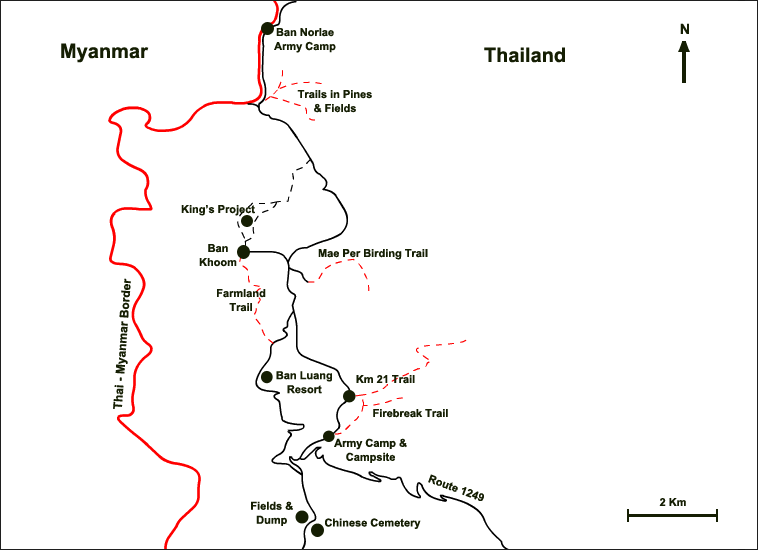
Farmland
Trail: Although not one of the best trails
in terms of bird diversity, this one can be used at times
when the cloud is locked in higher up, making visibility poor;
at these times many of the flocking birds descend into the
valley. There are still patches of forest along here and in
the past I have seen a number of good birds. White-browed
Laughingthrush is numerous and regularly found along here
and Common Rosefinch and Chestnut Bunting can be seen too.
In shady glades White-gorgetted Flycatcher often occurs and
raptors can often be observed flying along the valley; Common
and Oriental Honey Buzzards are frequently seen. A number
of trees with small flowers attract flowerpeckers and sunbirds
with Yellow-bellied Flowerpecker and Mrs Gould's Sunbird notable
highlights. White-browed and Rusty-cheeked Scimitar Babblers
are reliable on this trail and it is one of the best places
on Doi Ang Kang to find Russet Bush Warbler which has a very
distinctive song. This trail seems to ramble on for miles
for those who like to explore.
Mae
Per Forest Trail: This trail starts with a
sealed road towards some lodges where school parties seem
to stay and camping is possible. At the back of these lodges
a good birding tail begins with some of the most intact forest
on the mountain - it is worth walking along here a number
of times in order to find some of the best species.
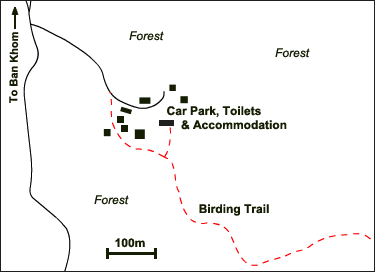 |
|
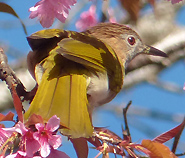
Mountain Bulbul
|
|
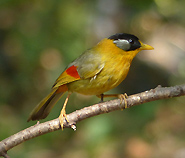
Silver-eared Mesia
|
|
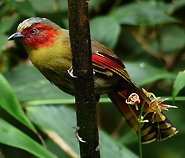
Scarlet-faced Liocichla
|
|
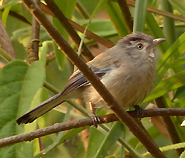
Blue-winged Minla
|
| (Photos by Nick
Upton) |
The best time to be birding along this trail is just as the
morning sun hits the treetops, which is actually some time
after first light due to the steep ridges blocking the early
morning sun. Parties of small flocking birds can be frequent
with Grey-cheeked Fulvetta, Blue-winged Minla, Golden Babbler,
Lesser Racket-tailed Drongo, Yellow-cheeked Tit, Mountain
Bulbul, Ashy Bulbul and Silver-eared Mesia being just a few
of the commonly seen species and sometimes there is a surprise
with them, perhaps Long-tailed Broadbill or Clicking Shrike-babbler.
A few farmed patches along here and scrubby vegetation around
them can attract Chestnut Bunting and Common Rosefinch as
well as Spectacled Barwing and if flowers are seeding then
small numbers of Crested Finchbill may be encountered. These
areas provide breaks in what can otherwise be thick forest
so it is worth waiting in these patches for birds to come
along as they are where the best views can be obtained.
In the shadier areas along the stream and gullies a number
of good birds can be found with some effort; Mountain Tailorbird
is common, Small Niltava, White-gorgetted Flycatcher and perhaps
Chestnut-headed Tesia. Rusty-naped Pitta and Pygmy Wren Babbler
also occur but finding them will probably take a huge effort.
Other really good birds I have seen along here include Spot-breasted
Parrotbill, Pale-billed (Lesser Rufous-headed) Parrotbill
(very rare) and Grey-breasted (black-throated) Parrotbill
as well as Scarlet-faced Liocichla. While it is never an easy
bird to locate birding along this trail may give the best
chance to see Spot-throated Babbler which may be heard singing
its sweet song in the breeding season and when it is wet White-crowned
Forktail is remarkably easy to see as it forages on the trail.
The patch of pine trees at the car park area can also be worth
birding in with species like Slender-billed and Marion Orioles,
Japanese Tit, Streak-breasted Woodpecker all regular and a
number of other small birds such as Chestnut-vented Nuthatch
are frequent here. In the "winter" months it is
always worth checking in the rubbish in the gulley behind
the main building where I have seen Black-breasted and White's
Thrush in the past.
This area is also a good choice if you like night birding
with regular sightings of Brown Wood Owl and Collared Scops
Owl. Mountain Scops Owl and Hodgson's Frogmouth can sometimes
be heard although finding them is a real challenge but seeing
Grey Nightjar hunting at dusk is more likely and I once saw
a Eurasian Woodcock roding here - the only record of possible
breeding in Thailand that I am aware of. In March-April the
fireflies here are one of the most spectacular natural events
that I have ever seen.
King's
Project : These gardens and farm plots are
part of a project initiated by King Bumiphol to take villagers
away from opium production and towards cash crop production.
Although the farmed areas are subject to intense pesticide
use the unmanaged parts of the property and fruit trees attract
some good birds and this is a good place for birding if the
weather higher up is poor as birds often get pushed down into
this little valley.
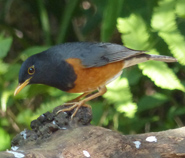
Black-breasted Thrush
|
|
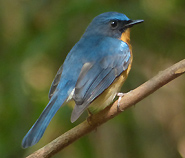
Hill Blue Flycatcher
|
|
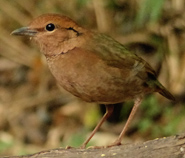
Rusty-naped Pitta
|
|
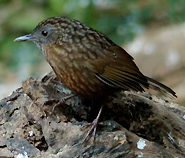
Streaked Wren Babbler
|
| (Photos by Nick
Upton) |
When trees are flowering here it is a great place to find
White-headed Bulbul; the best time for this species tends
to be between November and early January. Red-whiskered, Mountain
and Ashy Bulbuls are also often attracted to these trees and
the large trees with red flowers near the restaurant seem
to also lure in Streak-breasted Woodpecker, Maroon Oriole.
Slender-billed Oriole and Hair-crested Drongo.
Small flowering bushes in the garden are a magnet for Black-throated
Sunbird and Olive-backed Pipit is frequently seen foraging
on the ground between trees. Behind the restaurant is a shady
area surrounded by rocks where Black-breasted Thrushes often
feed on scraps from leftover meals. Sometimes other thrushes
winter here too with Scaly Thrush in most years and Blue Whistlingthrush
a resident.
Another excellent stakeout is behind the bamboo farm where
photographers and birders lure in birds with mealworms; please
be unobtrusive here and respect others, also do not overfeed
the birds or the next people to visit will have a long wait.
Black-breasted Thrush, White-tailed Robin, Hill Blue Flycatcher
and Rufous-bellied Niltava are usually here and can be joined
by others - Streaked Wren Babbler, Japanese Thrush, Rusty-naped
Pitta and others have been seen.
Ban
Nor Lae Army Camp: Unlikely as it may seem
the army welcome visitors to the small camp in the hilltribe
village of Nor Lae; just drive up to the barrier at the base
of the steep slope up to the camp and the sentry will open
it for you and birders can park at the top of the slope just
before a second barrier. The camp is small but it overlooks
some nice habitat on the Myanmar side of the border and there
are plenty of bushes and shrubs in the camp which host a few
interesting species. Please do remember that although visitors
are welcome this is sill a working military outpost so one
should respect the signs which state that certain areas are
out of bounds.
The small flowering bushes that encircle the lawn of the camp
always seem to attract small numbers of White-eyes which should
be studied closely as Oriental, Japanese and Chestnut-flanked
can occur. A resident group of Eurasian Tree Sparrows live
here but the flocks are worth checking as I once saw Russet
Sparrow here and there are single records of Brambling and
Chaffinch too. The small bushes also host Yellow-browed Warbler
and both Olive-backed and Purple Sunbird - an unusually high
altitude for this latter species.
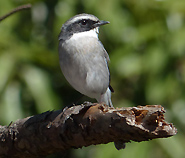
Grey Bushchat
|
|
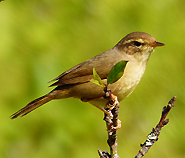
Yellow-streaked Warbler
|
|
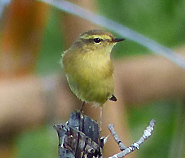
Buff-throated Warbler
|
|
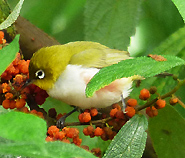
Chestnut-flanked White-eye
|
| (Photos by Nick
Upton) |
In the "winter" months this camp usually plays
host to a few Daurian Redstarts, the males of which are really
beautiful. This species can be quite skulking here but often
their quivering tail movement will give them away in the thick
vegetation.
In the long grassy areas in no-man's-land both Buff-throated
and Yellow-streaked Warblers commonly occur as migrants and
often Siberian Rubythroats can be heard calling from within
this dense vegetation too, although seeing them can be tough.
Grey Bushchat, Sooty-headed Bulbul and Long-tailed Shrike
will certainly be seen in no-man's-land and are likely to
be the first birds on visitor's "Myanmar list".
The viewpoint shelter is a good place to just stand and look
at the strange border situation where military camps resemble
something from medieval times and spending some time looking
out here can turn up some interesting surprises; I have seen
Spot-breasted Parrotbill, Large Hawk Cuckoo, White-browed
Laughingthrush while staring into Myanmar.
In the late afternoon this can be a good place to view large
numbers of Cook's Swift as they gather before roosting; a
close look may reveal Pacific Swift with them and other species
such as Asian House Martin.
Trails
in Pines & Fields : An obvious dirt track runs
from the road close to the village of Ban Nor Lae, right next
to a small shelter. There are always Olive-backed Pipits here
and there is a small trail running through the forest here
which is worth exploring. I have seen White-tailed Robin,
Speckled Piculet, Silver-eared Mesia and Daurian Redstart
here while Hume's Leaf Warbler can be found in the pines.
I have not followed the trail far so it is more or less uncharted
territory.
Ban
Luang Resort : These lodges are situated in
a limestone sink hole and are owned by a local man, Khun Tawatchai,
who runs his property in a way sympathetic to birds with several
bird feeding areas which make it a good area for birding in
as well as a nice place to stay.
 Bird
Watching Tours To Doi Ang Kang: If you are visiting
northern Thailand then Doi Ang Kang is an excellent
location, coupled with a visit to Doi Inthanon and/or
Doi Lang. Bird
Watching Tours To Doi Ang Kang: If you are visiting
northern Thailand then Doi Ang Kang is an excellent
location, coupled with a visit to Doi Inthanon and/or
Doi Lang.
At any time of year a good selection of colourful birds
can be seen and in the dry season a whole range of migrants
visit this location.
Contact me to arrange a birding trip and/or to discuss
the best bird watching options for you: nickupton@thaibirding.com. |
A small waterfall at the rear of the property is an excellent
place to see White-capped Water Redstart (River Chat) between
mid-November and late March as it emerges to feed on mealworms
supplied by Khun Tawatchai. Other birds that also join it
include Rufous-bellied Niltava, Black-breasted Thrush and
Hill Blue Flycatcher and sometimes other species may make
benefit of this food.
In the stream itself White Wagtail and Grey Wagtail are common
visitors and another feeding station close to the stream is
reliable for several species of Bulbul, Grey Bushchat and,
in cold weather, several species of Thrush including Grey-winged
Blackbird, Black-breasted Thrush and Grey-sided Thrush.
Around the gardens species such as Oriental Magpie Robin,
Taiga Flycatcher and White Wagtail are frequent while a little
bit of searching should also reveal Blue Whistlingthrush and
Long-tailed Shrike. If trees have flowers or fruit on them
some nice birds will visit to feed on them including Crested
Finchbill and White-headed Bulbul which makes quite a picture
as it feeds on pink cherry blossom. Towards the end of the
dry season, when things get hot Black-headed Greenfinch may
come to drink in the stream, perching atop fruit trees before
coming down to the water. A little before dusk this is also
a good place to look up and observe large numbers of Striated
Swallows.
Km 21
Trail & Firebreak Trail : This trail, along
with the offshoot to the firebreak and to the summit of Doi
Ang Kang, has long been a favourite with birders and for good
reason as the habitat supports a wide range of species. However,
over the years it has become overgrown meaning that actually
seeing the birds along here is not easy, particularly if you
are in a group; this is definitely an area where individuals
and very small groups will do best.
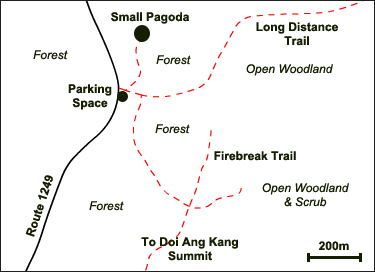 |
|
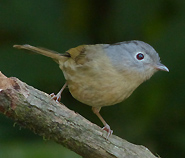
Grey-cheeked Fulvetta
|
|
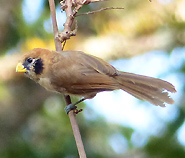
Spot-breasted Parrotbill
|
|
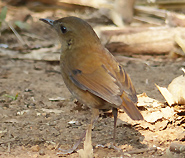
Lesser Shortwing
|
|
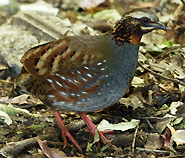
Rufous-throated Partridge
|
| (Photos
by Nick
Upton) |
There are frequently lots of flocking birds in this area
which are often revealed by the call of Grey-cheeked Fulvetta.
Many species will follow including Silver-eared Mesia, Golden
Babbler, Yellow-cheeked Tit and Bianchi's Warbler often joins
them here, listen out for its distinctive call to clinch its
identification from other Seicercus warblers.
The undergrowth is thick here and some skulking species can
be found with some patience and a little luck. White-gorgetted
Flycatcher can often be heard singing here but seeing it can
be really hard while Lesser Shortwing can be impossible until
the wet season when it struts around on the trail. In most
"winters' a Chestnut-headed Tesia holds a territory in
this area and Pygmy Wren Babbler can usually be heard singing
its distinctive "three blind mice" song. Other secretive
birds I have seen along here include Rufous-throated Partridge
and Pale-footed Bush Warbler and a very lucky few have managed
to glimpse Spot-breasted Laughingthrush - if you manage to
repeat that feat then buy a lottery ticket because your luck
is blessed.
Other good birds that can be found here with patience include
White-necked Laughingthrush, Speckled Piculet, Scarlet-faced
Liocichla and this is where I saw my first Spot-breasted Parrotbill.
In the rainy season birders have a good chance of finding
Green Cochoa here and Lesser Cuckoo can usually be heard calling,
one of the few sites in Thailand for this species.
Firebreak
Trail : A fairly wide, but steep, firebreak
offers a chance to see birds out in the open as they feed
and cross the trail. Species such as Mountain Bamboo Partridge,
White-browed Laughingthrush, Gould's Sunbird and Chestnut-bellied
Rock Thrush can be found along here and the views from the
top of the ridge are excellent; this trail is ridiculously
steep though so if you have any mobility issues do not attempt
to walk up it.
Heading uphill in the opposite direction from this trail is
another steep trail to the summit of Doi Ang Kang. Some good
birding can be had along the first few hundred metres with
good views over some open habitat where Crested Finchbill
is often seen.
Army
Camp & Campsite : These areas and forest
along the road can be very birdy at times and it is possible
to see most of the commoner birds of the mountain here quite
quickly. In the pine trees here large numbers of Leaf Warblers
occur including Hume's, Yellow-browed, Buff-barred and Greenish
Warblers while Chestnut-vented Nuthatch, Japanese Tit and
Blyth's Shrike-babbler are never far away. Several species
of Flycatcher often occur here too although they seldom make
themselves obvious so take some time to look for Little Pied
Flycatcher, Rufous-gorgetted Flycatcher, Slaty-backed Flycatcher
and perhaps other species. In previous years a couple of Chestnut-bellied
Rockthrushes occupied the pines too but with clearing of many
of the pine trees and concreting of much of the copse for
a visitor centre a shy bird like this is likely to find somewhere
else to go.
In the more open habitats which are overlooked by the camps
skulking resident species include White-browed Laughingthrush,
Rusty-cheeked Scimitar Babbler and Hill Prinia but in the
"winter" Buff-throated Warbler, Aberrant Bush Warbler,
Grey-crowned Warbler and Chestnut Bunting are usually hiding
in the long grass too. Some of the most sought-after birds
of the north may be found here by lucky birders with Grey-headed
Parrotbill and Scarlet-faced Liocichla always possible as
well as Spectacled Barwing and Spot-breasted Parrotbill. It
is also a good place for Shrikes with Long-tailed Shrike resident
here while Brown Shrike and Grey-backed Shrike are regular
migrants; be careful not to misidentify lucionensis
Brown Shrikes as Grey-backed Shrikes!
A number of trees along the road produce flowers and fruits
and these attract a lot of species to feed upon them. Mrs
Gould's Sunbird is best observed under these conditions and
Mountain Bulbul, Striated Bulbul, Ashy Bulbul and Fire-breasted
Flowerpeckers are likely to join them.
Chinese
Cemetery, Fields & Dump : This open area
has some disused farmland and orchards on the West side of
the road and a few Chinese tombs on the East side, hidden
among the scrubby vegetation. This is by far the best site
to see Brown-breasted Bulbul, a species with a very restricted
range within Thailand, but easy to observe here alongside
Sooty-headed and Red-whiskered Bulbuls.
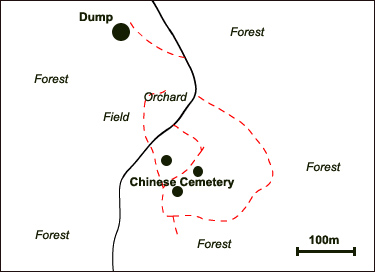 |
|
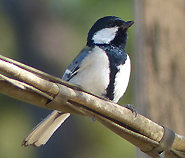
Japanese Tit
|
|
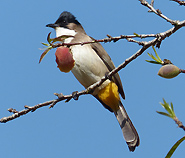
Brown-breasted Bulbul
|
|
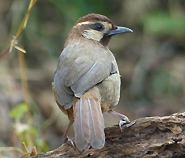
White-browed Laughingthrush
|
|
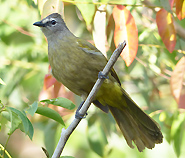
Flavescent Bulbul
|
| (Photos
by Nick
Upton) |
The open nature of this spot makes it excellent for observing
large flocks of Cook's Swift and usually Fork-tailed Swift;
Asian House Martins also often take advantage of the skies
here too. However, birding this area can be quite difficult
at times although there are some good species that are always
present including White-browed Laughingthrush, Rusty-cheeked
Scimitar Babbler, Hill Prinia and Siberian Rubythroat.
The undergrowth here undoubtedly holds some interesting birds
but it takes a bit of work to find them. Yellow-streaked and
Buff-throated Warblers are usually present as migrants and
this is one place where Aberrant Bush Warbler is at its most
common, just listen for its strange, harsh "pishing"
call. Other species in the undergrowth here include Yellow-eyed
Babbler, Hill Prinia and Rufous-fronted Babbler but there
is also the chance of something rarer - Russet Bush Warbler
should occur at this spot and in November I have noticed Manchurian
Bush Warbler perhaps on passage as I have never seen it in
any other month.
In the overgrown orchard here Olive-backed Pipits usually
forage on the ground and it is likely that birders can also
find Little Bunting feeding with them. The trees attract many
Bulbuls when they are fruiting and Mrs Gould's Sunbird feeds
on the blossom when they are in flower. Long-tailed Shrike
is resident here as is the przewalski subspecies
of Eastern Stonechat both of which are easily observed.
A short track leads to a smelly dump and of course this can
attract a few birds to feed on scraps particularly during
migratory periods when birds need food. I have seen Eyebrowed
Thrushes feeding here and it is a good spot to see White-browed
Laughingthrush in the open. The adjacent open woodland plays
host to Japanese Tit and White-throated Fantail as well as
a few flycatchers including Little Pied and Hill Blue Flycatchers.
This area has lots of low trees which make it a good spot
to study difficult Phylloscopus warblers and it is
a good spot to look for Chinese Leaf Warbler, Pallas's Leaf
Warbler among the much commoner Davison's and Yellow-browed
Leaf Warblers.
Ban
Arunothai Road: The road heading from the Chinese
cemetery south towards Ban Arunothai passes through lots of
good habitat and birding spots which can be visited as one
either enters Doi Ang Kang or leaves. Just 500m to 1km south
of the cemetery is some pine forest where a few pairs of Mrs
Hume's Pheasant persist although seeing them is extremely
tough; at Km 31 the road is extremely steep and mature pines
remaining here are the habitat of Giant Nuthatch, Slender-billed
Oriole and Hume's Leaf Warbler; Km 25 is an excellent place
to stop in the early morning for White-browed Scimitar Babbler,
Crested Finchbill, Grey Treepie, White-browed Shrike Babbler,
Striated Bulbul and many more birds typical of the habitat,
sometimes Grey-headed Parrotbill puts in an appearance here. |
Facilities |
| 
|
Doi Ang Kang used to have a lot of accommodation options
but in late 2018 they were all closed down for an undisclosed
reason. My favourite place to stay, Ban Luang Resort, was
a casualty of this order as was every other hotel/guesthouse
in the area. Conversations with locals indicate that there
will be no change in the foreseeable future and they will
remain closed. Currently the only place to stay on site in
the army campsite which has a toilet/shower block and some
small restaurants that open early in the morning. It may be
surprising to learn that even the luxurious Ang Kang Nature
Resort has been closed down and demolished!
With this development the most convenient place to stay and
visit Doi Ang Kang is in the town of Fang. There are lots
of places to choose from in this town with Tangerine
Ville Hotel and Sleeping
Tree Hotel being my two personal favourites,
both offering comfortable rooms. Fang has a full range of
facililites including a hospital, banks and supermarket.
In the village some very good local food is available, both
of my favourite restaurants are in the street behind the buildings
one sees when approaching the village. These two places are
both run by enthusiastic guys who produce a mixture of Yunnan
and Thai cuisine with menus with photos/English script. Just
to reiterate, although there used to be plenty of accommodation
in the village, it has all been shut down.
The small shops in the village sell just about everything
including excellent one-size-fits-all gloves and emergency
raincoats if the rain sets in unexpectedly as it sometimes
does here. All the shops sell souvenirs and a speciality of
this village is dried fruit grown in the King's project, which
is sold in virtually every shop - it is very sweet and delicious.
Local fruit wine is also sold in most shops for 100 baht per
bottle; if you choose to try it, it will certainly be one
of the most memorable experiences of your trip! The market
has an ATM machine these days which takes overseas bank cards
so that you have some cash to spend - try the fresh ginger
tea and almonds baked in butter, both are delicious. |
Some Useful Books |
 Thrushes Thrushes
This lovely book covers all of the thrushes in the
world and is a useful reference for anyone hoping to
see some migratory thrush species in northern Thailand.
Beautiful plates by Ren Hathaway are accompanied by
insightful and extensive species accounts.
|
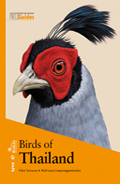 Birds
of Thailand
Birds
of Thailand
This field guide has set new standards in identifying
birds in the wild in Thailand. With the most up-to-date
taxonomy of any publication this is the book you need
if you are birdwatching in Thailand. Forget all of the
older guides and buy this one.
|
|
Other Related Pages |
Doi Ang Kang
Bird Checklist
Birdwatching
Tours
Destruction
of Giant Nuthatch Nesting Habitat at Doi Ang Kang
Other Northern Thailand Birding Locations |
Trip Reports |
3
Days Doi Ang Kang & Doi Lang, 26-29th December 2009
- by Nick Upton
Rainy
Season Birding Tour of Thailand, 1st-14th July 2009
- by Nick Upton>
In
Search of 4 Target Species in the North, 28-29th July 2008
- by Nick Upton
Wet Season
Tour of Thailand, 17-25th July 2008 - by Nick Upton
Northern
Thailand, 14-19th February 2007 - by Peter Ericsson
Thailand
Tour, 10-24th January 2007 - by K. David Bishop
Doi Ang
Kang, 30th May-1st June 2006 - by Dominic Le Croissette
Northern
Thailand, 6-13th October 2004 - by Peter Ericsson
Mae Fang,
Doi Ang Kang & Golden Triangle, 14-22nd March 2004
- by Peter Ericsson
Doi
Angkhang and Doi Inthanon, 3-5th November 2002 - by
Peter Ericsson
Doi Angkhang,
2nd March 2002 - by Peter Ericsson |
 Bird
Watching Trips:
Bird
Watching Trips:
Doi Ang Kang is an excellent site and almost a must-visit
location on bird watching trips to the north of Thailand.
It is worth including a visit to Doi Ang Kang in short
trips to the north and on longer tours.
Look at some itinerary ideas, Thailand
bird tours, or contact me for information: nickupton@thaibirding.com. |
|
Related Blog Entries |
|
Photo Galleries |
Select the thumbnail photos to see larger images.
|
|
Around Doi Ang Kang

View into Myanmar |
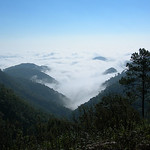
Sea of Fog |
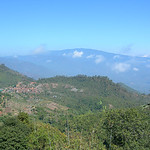
Hilltribe Village |
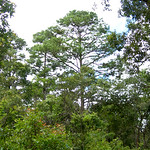
Giant Nuthatch Tree |
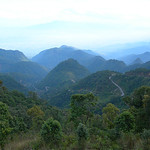
The Road to Fang |
Butterflies at Doi Ang Kang
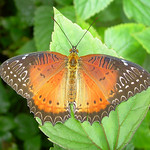
Red Lacewing |
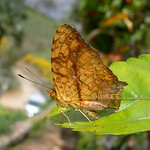
Common Jester |
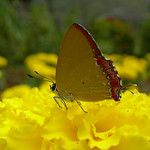
Golden Sapphire |
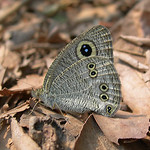
Common Fivering |
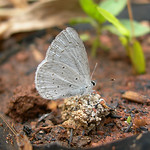
White-banded Hedge Blue |
|
Selected eBird Lists |
- 15
February 2020, Doi Pha Hom Pok NP--Doi Angkhang (general
area) - by Nick Upton
- 05 December
2019, Doi Pha Hom Pok NP--Doi Angkhang (general area)
- by Nick Upton
- 05
March 2019, Doi Pha Hom Pok NP-- Doi Angkhang (general area)
- by Nick Upton
- 12
February 2019, Doi Pha Hom Pok NP--Doi Angkhang (general
area) - by Nick Upton
- 10
January 2018, Doi Pha Hom Pok NP--Ban Luang Resort on Doi
Angkhang - by Nick Upton
- 12
December 2017, Doi Pha Hom Pok NP--Doi Angkhang-Chinese
Cemetery & Dump - by Nick Upton
- 04
January 2017, Doi Pha Hom Pok NP--Doi Angkhang Royal Agricultural
Station - by Nick Upton
- 03
December 2016, Doi Pha Hom Pok NP--Doi Angkhang-Ban Nor
Lae Army Camp - by Nick Upton
- 12
February 2016, Doi Pha Hom Pok NP--Doi Angkhang -Chinese
Cemetery & Dump - by Nick Upton
- 13
March 2010, Doi Pha Hom Pok NP--Mae Per Trail on Doi Angkhang
- by Nick Upton
- 15
November 2009, Doi Pha Hom Pok NP--Doi Angkhang Royal Agricultural
Station - by Nick Upton
- 11
July 2009, Doi Pha Hom Pok NP--Km. 21 Trail on Doi Angkhang
- by Nick Upton
- 15
November 2008, Doi Pha Hom Pok NP--Doi Angkhang-Chinese
Cemetery & Dump - by Nick Upton
- 29
July 2008, Doi Pha Hom Pok NP--Mae Per Trail on Doi Angkhang
- by Nick Upton
- 27
October 2002, Doi Pha Hom Pok NP--Doi Angkhang-Chinese Cemetery
& Dump - by Nick Upton
|
|
|
|
|
I
Hope You Enjoyed This Page If
you found the information you were looking for here
please let others know by liking this page on Facebook
and Tweeting it.
|
|
|
If you found this page useful and want to say thanks, you
can buy me a beer.
 |
|
|
|
|
| |
|
Print on demand T-shirts with original designs
featuring the Birds of Thailand available now - Thaibirding
T-Shirt Store
|
|
| |
| |
|
| |
|
|
|
|
|
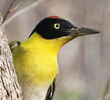 Cambodia,
12-26th March 2025 - Giant Ibis, Bar-bellied Pitta,
Greater Adjutant, Mekong Wagtail, Cambodian Tailorbird,
White-rumped Vulture: £4050 Cambodia,
12-26th March 2025 - Giant Ibis, Bar-bellied Pitta,
Greater Adjutant, Mekong Wagtail, Cambodian Tailorbird,
White-rumped Vulture: £4050
|
|
|
|
|
|
|
|
|
|
|
|
|
|
|
| |
|
|